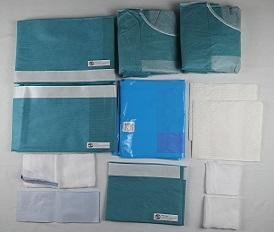Surgeons should place disposable medical surgical kits in the specified position during the operation so that they can take it at any time and prevent collisions with each other. Especially sharp instruments should be used carefully. For example, ophthalmic scissors should not be used to cut thick and tough tissues, gauze rolls, cotton rolls, etc.
Long-term storage of disposable medical surgical kits should be coated with a layer of vaseline. Frequently used instruments should be wiped with liquid paraffin after the blood is cleaned to prevent rust. Sharp instruments and blunt instruments should be stored separately. Sharp instruments can't be sterilized by high pressure and boiling. Only in very urgent situations, they can be sterilized by boiling for a short time (3 minutes) to avoid damaging the sharp edges.
Before disinfecting disposable medical surgical kits, operating room personnel should carefully check whether the surgical instruments are adequate and suitable. For example, whether the tip of the scissors can be closed tightly, and the two strands should be opened and then placed in a sterilization tray for sterilization. Linear knives and gun-shaped knives can be used to check whether the blade is sharp with an enlarged mirror or a test drum, and the tip is wrapped with cotton before disinfection. For various trephines, pay special attention to cleaning the oil in the drill barrel. After rubbing, it can be disinfected. For each trephine, the number of times it has been used should be recorded for easy selection during surgery. The elasticity of the two strands of the iris forceps should also be checked.
Most disposable medical surgical kits are disinfected by soaking and disinfecting with 1/1000 Xinjie Ermei solution containing 0.5% sodium nitrite. Soaking for 30 minutes can achieve the purpose of disinfection, add sodium nitrite to prevent rust. Sterilization trays for frequently soaked instruments should be autoclaved every 2 to 4 weeks. And replace with new disinfectant.


